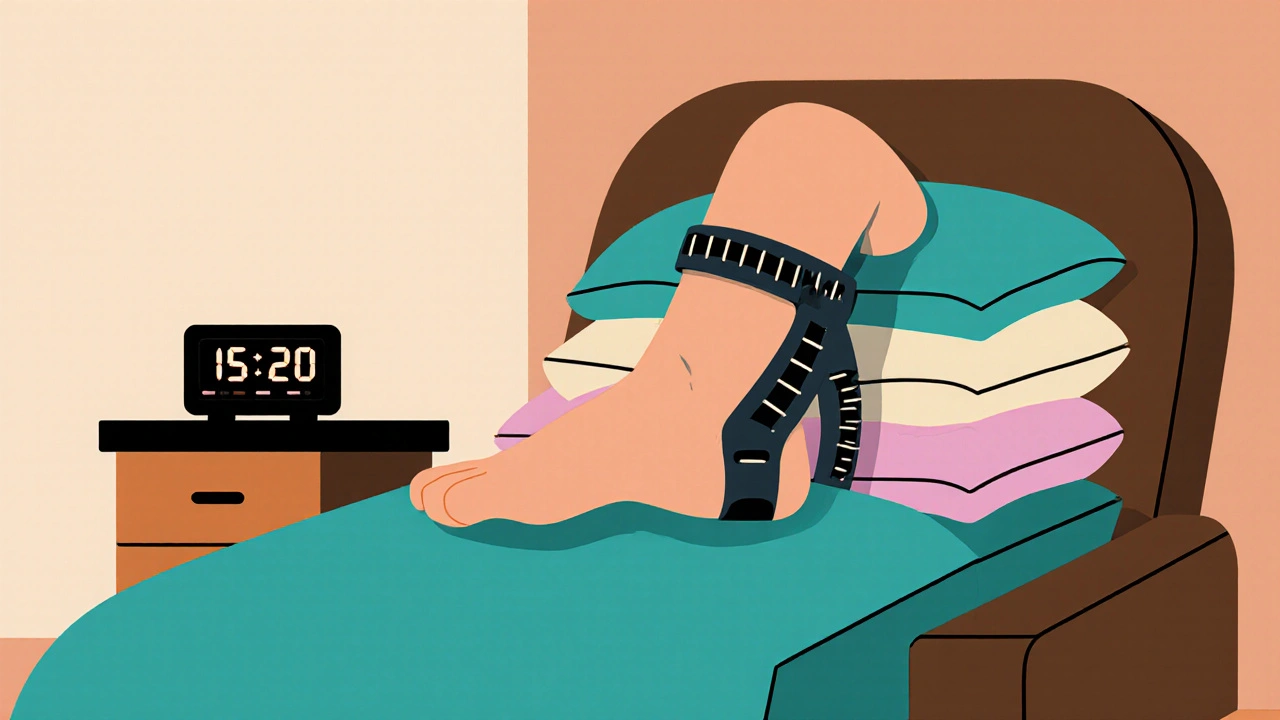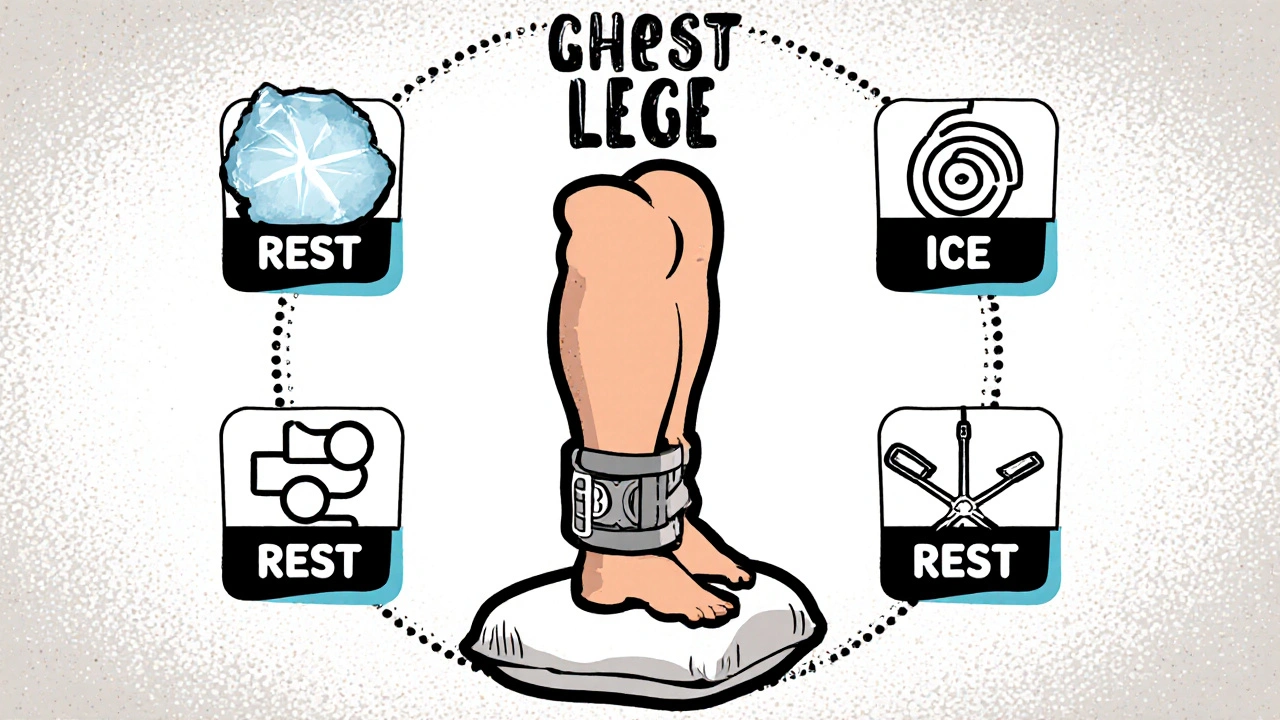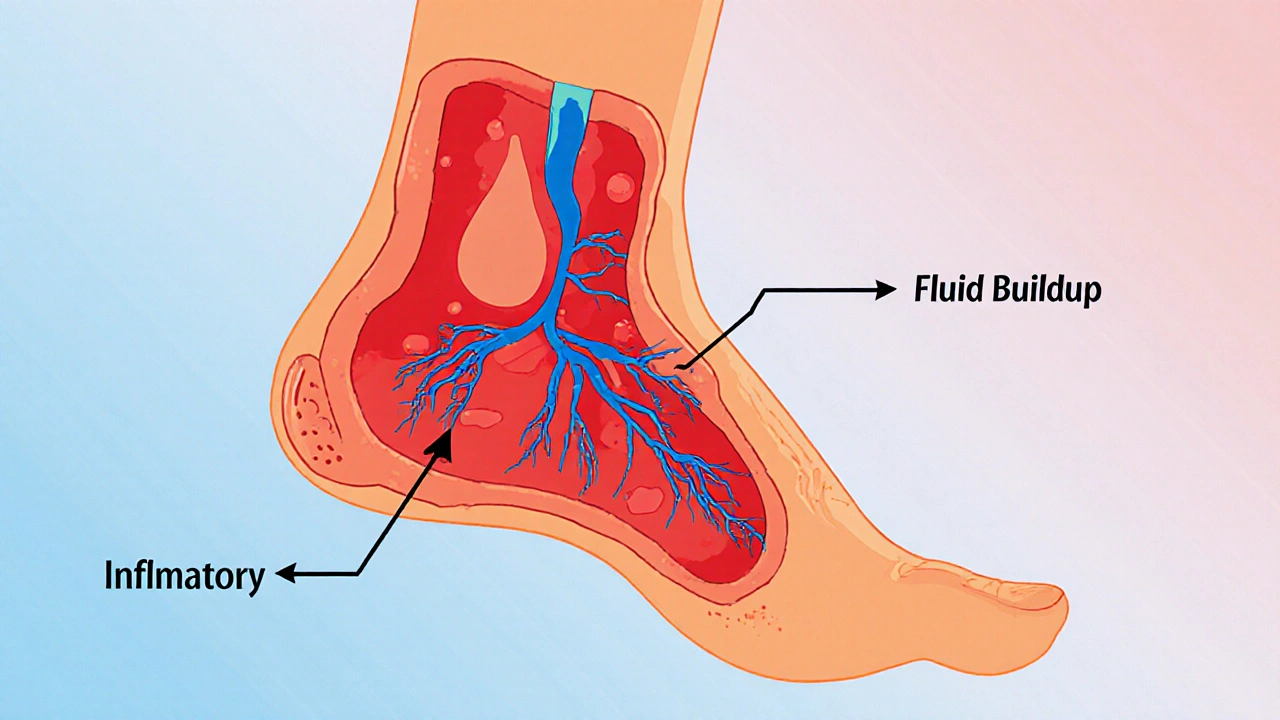Elevation Schedule Calculator for Swelling Reduction
Use this tool to create a professional-grade elevation schedule based on medical guidelines. Ideal for sprains, strains, and post-surgical recovery.
Key Takeaways
- Rest slows down the inflammatory cascade and prevents further tissue damage.
- Elevating the injured area uses gravity to boost fluid return to the heart.
- Combine rest and elevation with ice and compression for the full RICE protocol.
- Typical elevation angles are 30‑45° and should be maintained for 15‑20 minutes every hour.
- Seek medical attention if swelling persists beyond 48‑72 hours or is accompanied by severe pain.
Understanding Swelling
When tissue is injured, blood vessels leak fluid into the surrounding space. This fluid buildup is called Swelling the accumulation of interstitial fluid that makes the area appear puffy and feel tight. Swelling isn’t just cosmetic; the excess fluid raises pressure, squeezes nerves, and slows down the delivery of oxygen and nutrients.
Two biological engines drive swelling: Inflammation the body's defensive response that releases chemicals like histamine and prostaglandins and the Lymphatic System a network of vessels that drains excess fluid and waste from tissues back into circulation. When either system is overloaded, fluid pools and the area swells.
How Rest Helps Control Swelling
Rest may sound simple, but it does more than give you a break. By limiting movement, you reduce the mechanical stress that would otherwise keep blood vessels leaky. Rest also lowers the metabolic demand of the injured muscles, meaning fewer waste products that the lymphatic system must clear.
In practical terms, aim for complete immobilisation of the injured part for the first 24‑48 hours, unless a healthcare professional advises otherwise. For a sprained ankle, for example, use a brace or splint to keep the joint stable. Even short bouts of activity can reignite the inflammatory response, so schedule gentle rest periods throughout the day.
Why Elevation Is a Game‑Changer
Elevation works on the principle of gravity. By raising the swollen limb above heart level, you create a pressure gradient that encourages fluid to flow back toward the circulatory system. This reduces the hydrostatic pressure in the tissues and eases the swelling.
Studies on post‑operative knee patients show that elevating the leg at a 30‑45° angle for 15‑20 minutes every hour can cut swelling volume by up to 40% within the first 48 hours. The key is consistency: the longer the limb stays low, the more fluid re‑accumulates.

Combining Rest & Elevation with Other RICE Steps
The classic RICE protocol (Rest, Ice, Compression, Elevation) bundles four proven techniques. While this article focuses on rest and elevation, pairing them with ice therapy and compression maximises swelling reduction. Ice constricts blood vessels, slowing fluid leakage, and compression prevents fluid from spreading into surrounding tissues.
| Component | Primary Action | Typical Duration |
|---|---|---|
| Rest | Limits mechanical stress and metabolic demand | 24‑48hrs (initial), then as needed |
| Ice | Vasoconstriction to reduce fluid leakage | 15‑20min every 2‑3hrs |
| Compression | Prevents fluid spread, supports tissue | Continuous, adjusted for comfort |
| Elevation | Gravity‑driven fluid return to circulation | 15‑20min every hour |
When you apply all four, each step reinforces the others. For instance, a well‑compressed ankle stays in place better, making elevation easier.
Practical Tips to Implement Rest and Elevation
- Set up an elevation station: Use pillows, a recliner, or an adjustable bed to keep the limb at the right angle without straining your back.
- Schedule reminders: Phone alarms or a simple timer can prompt you to lift and lower the limb regularly.
- Use supportive devices: Braces, splints, or even a simple elastic bandage can keep the injured area from moving unintentionally.
- Stay hydrated: Adequate fluid intake helps the lymphatic system flush excess fluid more efficiently.
For common injuries like a bruised shin or a swollen wrist, you can combine these tips with a pillow stack for elevation and a lightweight cast for rest. The goal is to keep the affected part still and higher than the heart as often as possible.
Common Mistakes to Avoid
Many people think “a little movement won’t hurt,” but even mild activity can re‑open leaky capillaries. Another frequent error is elevating too high, which can cause blood pooling in the upper body and feel uncomfortable. Aim for a modest incline that keeps the limb comfortably above heart level.
Skipping the compression layer is another pitfall. Without compression, fluid can slip into adjacent tissues, making the swelling reappear once you lower the limb.

When to Seek Professional Help
If swelling persists beyond 48‑72hours despite consistent rest and elevation, it may signal an underlying issue like Venous Insufficiency a condition where veins struggle to return blood to the heart, leading to chronic edema or a hidden fracture.
Additional red‑flags include:
- Severe, throbbing pain that worsens with elevation.
- Numbness or tingling, indicating possible nerve compression.
- Skin discoloration, warmth, or fever, which could suggest infection.
Putting It All Together
The bottom line is simple: rest protects the injured tissue, elevation drains the excess fluid, and together they form the backbone of effective swelling management. Pair them with ice and compression for optimal results, stay consistent, and watch the swelling shrink day by day.
Frequently Asked Questions
How long should I keep my limb elevated?
Aim for 15‑20 minutes every hour during the first 48 hours, then adjust based on how the swelling responds. The key is to maintain the angle above heart level each time you lift.
Is it okay to walk around while my ankle is resting?
For the initial 24‑48 hours, keep the ankle immobilised with a brace or splint. Light, non‑weight‑bearing movements can be introduced only after swelling starts to subside and a professional gives the green light.
Can I combine elevation with a hot compress?
During the acute phase (first 48‑72hours), cold is preferred because it limits blood flow. Heat can be introduced later to improve flexibility, but keep the limb elevated only if swelling is still present.
What if I don’t have pillows to elevate my leg?
A sturdy chair, a recliner, or a folded blanket can serve as a makeshift elevation platform. Just ensure the height keeps the limb at a 30‑45° angle; you can test it by holding a smartphone against your wrist-if the screen faces upward, you’re close to the right angle.
When should I see a doctor for swelling?
If swelling hasn’t improved after 48‑72hours of consistent rest and elevation, or if you notice severe pain, numbness, skin colour changes, or fever, seek medical attention promptly.

9 Comments
Malia RiveraOctober 17, 2025 AT 14:29
Rest is the silent sentinel that watches over injured tissue, allowing the body to regroup before the storm of inflammation can strike again. In the grand tapestry of healing, patience is a virtue cultivated by those who understand that haste only fans the flames of swelling. Elevating a limb is like giving the circulatory system a gentle hand‑up, coaxing fluid back where it belongs. For anyone who values strength, protecting the body with these simple steps is a patriotic act of self‑care.
Frank DiazOctober 17, 2025 AT 15:52
While the poetic picture is appealing, the science demands concrete action: without consistent compression, elevation alone cannot counteract the hydrostatic pressure that drives edema. The literature shows a 30‑45° incline for 15‑20 minutes each hour reduces fluid volume significantly, but only when paired with proper bracing. Ignoring those specifics reduces the plan to a vague mantra rather than a therapeutic protocol.
Mary DaviesOctober 17, 2025 AT 17:15
The swelling beast awakens in the quiet night, whispering promises of pain and immobility, yet we hold the power to silence its roar. By granting the injured limb a throne above the heart, we summon gravity as an ally, coaxing the rogue fluid back to its rightful channels. Rest, then, is not laziness but a strategic withdrawal, a chess move that forces the opponent to pause. Each hour of elevation is a stanza in the epic poem of recovery, each minute a beat against the drum of inflammation. The lymphatic highways, though invisible, respond to the gentle slope, clearing the debris left by cellular warfare. Compression, like a steadfast guardian, stands between the swelling tide and the vulnerable tissues. Ice, the icy emissary, contracts blood vessels, buying precious time for the rest of the regime. When these four pillars align, the swelling diminishes like a sunrise over a fog‑shrouded valley. Remember, the body is a symphony; rest is the pause, elevation the crescendo, and the rest the harmonious resolution. Do not be tempted by the siren call of premature motion; it only revives the leak that you have worked so hard to seal. Hydration fuels the lymphatic flow, ensuring the rivers of plasma run clear. A supportive brace acts as a scaffold, preventing accidental micro‑movements that could reopen capillary gates. The angles matter – too steep and the heart must work harder, too shallow and gravity’s aid wanes. Consistency is the key that unlocks the door to reduced edema. If after 48 hours the swelling clings stubbornly, it may signal deeper issues, warranting professional eyes. In those moments, let the doctors be your co‑conductors, not the villains of your saga.
Valerie VanderghoteOctober 17, 2025 AT 18:39
Listen, I’ve been there on the court, limping after a nasty ankle twist, and let me tell you, the world doesn’t stop because you’re in pain. I set up a makeshift throne with every cushion I could find, propping my leg up while I binge‑watched my favorite series, because why should recovery be boring? The trick isn’t just the angle; it’s the ritual – every hour, I’d hear the alarm, shuffle my pillows, and feel that sweet gravity pull. It’s funny how people think you need fancy equipment, when a sturdy chair and a blanket do the job just fine. And while you’re at it, slap on a compression sleeve – it’s like giving your leg a hug that says, “I’m not letting you swell up again.”
Darryl GatesOctober 17, 2025 AT 20:02
Great points about consistency! For anyone setting up an elevation station, I recommend using a stack of firm pillows that keep the limb at about a 35° angle – you can check with a smartphone tilt app. Pair this with a breathable compression wrap, making sure it’s snug but not cutting off circulation. Schedule a timer on your phone for every hour; a quick five‑minute lift can dramatically accelerate fluid return. And remember to hydrate; the lymphatic system moves fluid more efficiently when you’re well‑supplied with water.
Kevin AdamsOctober 17, 2025 AT 21:25
Rest, ice, compression, elevation – repeat.
Katie HenryOctober 17, 2025 AT 22:49
Esteemed members of this community, I wholeheartedly applaud the diligent application of the RICE protocol. Your commitment to disciplined rest and precise elevation exemplifies exemplary self‑care. May your swelling recede swiftly, and may you emerge from this trial stronger and more resilient. Continue to uphold these best practices with unwavering dedication.
Joanna MenschOctober 18, 2025 AT 00:12
What most don’t realize is that the medical industry pushes the RICE routine to keep us dependent on over‑the‑counter products and follow‑up visits. The real agenda is about profit, not healing; the subtle messaging keeps us passive while the system harvests data. Stay skeptical and question every guideline, because hidden motives lurk behind even the simplest advice.
RJ SamuelOctober 18, 2025 AT 01:35
Oh, absolutely – I’d argue that elevating a limb is overrated; the body’s own pumps can handle fluid redistribution without our meddling. Why not just let gravity do its thing and skip the pillows? It’s all just a convenient excuse for people to feel they’re doing something productive while they’re actually just lying around.